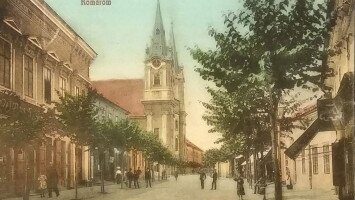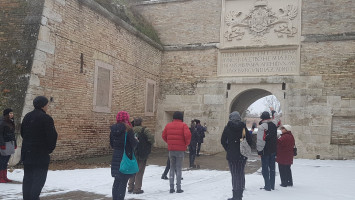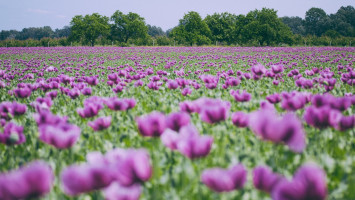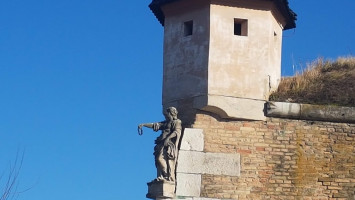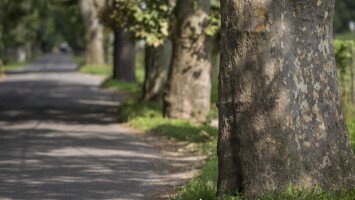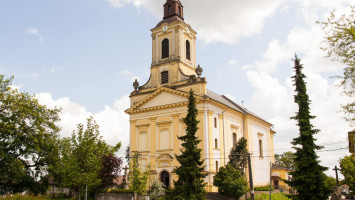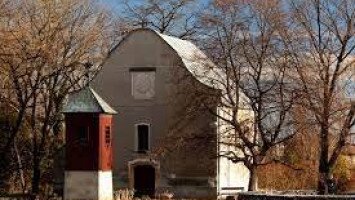
History of Moča
Get to know the village of Moča, its territory was inhabited in the Neolithic
It is one of the southernmost villages in southern Slovakia, located close to the Danube. The first mention of it comes from 1208.
Dunaj river. Photo: TASR / Henrich Mišovič
Moča September 4 (TASR) - The village of Moča in the Komárno district has 1,100 inhabitants. It is located between Štúrovo and Komárno. It is one of the southernmost villages in southern Slovakia, close to the Danube. The vast majority of citizens, 92 percent, are of Hungarian nationality. In the village there is a primary school with Hungarian as the language of instruction with almost 100 pupils, Slovak children, the number of which is up to 10, go to the surrounding villages. The village was historically connected to the river Danube. The village management also plans for the future in close connection with the largest river in Europe. In the previous regime, this connection with the river was interrupted in the last 50 years, it contains created borders, which were strictly guarded by the armed forces.
Various traditional activities, such as fishing, transporting goods and people from one shore to another, have been banned. There is an intense life in the world by the rivers and we want to get this life back, "the mayor emphasized. He underlined that currently, a large part of the population does not find a job in their place of permanent residence, unemployment is at the level of the Slovak average. "Several, almost 200 people go to work in Hungary, Esztergom, and Komárom and several dozen people have found employment abroad, in Austria and England," he says, adding that for logistical reasons building an industrial park directly in the village is out of the question. He noted that in decades, the inhabitants of the village have changed the workers in the cooperative, this opportunity was lost after its demise. "At that time, the cooperative needed a lot of manpower in viticulture or animal production. After the demise of the agricultural cooperative, the new owners replaced the human workforce with high-performance machines, "the mayor explained. He added that there is no longer any animal husbandry in the village.
The mayor emphasized that the main point of the municipality's priorities is the creation of new jobs so that young people do not leave to bigger cities. "We want to create a living space for our living," he underlined. He repeatedly pointed out the possibilities provided by the proximity of the Danube and the use of the agricultural character of the micro-region. "Our effort is to create an agricultural-relaxation or tourist region," he concluded.
The territory of the village was inhabited in the Neolithic
The village of Moča lies on almost 1,800 hectares, the first mention of which comes from 1208. The village is inhabited by Christians, 66 percent are of the Reformed faith, 27 percent are Roman Catholics. The territory of the village was inhabited in the Neolithic, there was a settlement of iron culture, Eneolithic with fluted pottery, North Pannonian culture from the Early Bronze Age, Roman Barbarian, skeletal graves from 10-11. century, said for TASR elementary school teacher, local historian Koloman Rácz.
The name of the village gradually changed from Moch (1208), Mooch (1274), Nagmoch (1425), Mocs (1773) to today's name Moča, in Hungarian Dunamocs. "It belonged to the property of the queens on the Komárno estate, to the Esztergom archbishopric from 1291. Part of the village belonged to the Báthory family until the middle of the 16th century, then the village was ravaged by the Turks," the historian explained.
According to him, in 1699 it had 300 inhabitants, a few years later 15 households, and in 1720 already 25 households. At the end of the 18th century, they counted 146 houses with 872 inhabitants. In 1828, the number of houses increased to 351 with 2,137 inhabitants engaged in agriculture, fishing, and shipping. "In 1821, the guild of local millers is mentioned. Until 1945, there were 18 watermills. In the years 1938-1945, the village was annexed to Hungary. The flood in 1965 destroyed more than 100 houses, "said Rácz. He added that primitive dams until the middle of the 18th century were insufficient. Settlement conditions determined the danger of floods, no houses were built in the village in lower places.
"In the second half of the 19th century, the flood was ravaged several times. The flood in 1892 was so great that from Moča to Búča, even to Mužla chotár, it looked more effective, "the historian explained. The natural disaster occurred in 1965 when the system water level rose from mid-March. "Nobody knew that as a result of the spring melting of snow and rich rain, several people would leave their homes," Rácz said. At present, after the construction of the dam and the Gabčíkovo Waterworks, this danger no longer exists.
The village by the Danube is building its future on tourism
The proximity of the Danube is a strategic advantage. He stated the mayor of Moča in the Komárno district of Banai Tóth Pál.
“Living on the water and enjoying all the opportunities that the river offers. It has a long-term importance, we cannot implement this strategy immediately, it is a process that probably never ends. First step we have already done so, and we need to change the mentality of the people in order to become an interesting destination for tourists, "Banai emphasized, adding that the situation in the field of tourism is currently changing, people no longer want to visit countries that are endangered in terms of security. "We are not in danger of terrorist attacks," he said. According to him, this statement can also be seen in the number of visitors to the surrounding thermal baths in Štúrovo, Patince, as well as in Komárom, Hungary.
As he said, these facilities already offer quality services and are safe. "We also want to provide a pleasant environment for tourists in our village. Locals must learn to provide services that attract visitors. We already have village tourism in our country and we are finding that we are an interesting destination, " said the mayor.
He reminded that there is an international Eurovelo 6 cycle route near the village, which connects almost all of Europe from the Atlantic Ocean to the Black Sea. A very popular route is Vienna - Budapest. "Since the whole route is not finished yet, our effort is to build a complete cycle route between Komárno and Štúrovo. Last year, we completed the section Moča - Komárno, where our village was the leading partner, "he said. He added that the project was implemented from European funds under a cross-border cooperation program. A section from the neighboring village of Kravany nad Dunajom to Štúrovo is still waiting to be completed. After the construction of this cycle route, a connection between the Štúrovo and Komárno bridges would be created.
The exhibits in the Museum of National History belong to the national monuments
In the village of Moča, in the building of the former notary's office, later the municipal office, there is currently a National History Museum. The visitor can get acquainted with the history and folk culture of the village. There are exhibits, documents, photographs that show the life of the oldest inhabitants, the museum's founder, and administrator Helena Szegiová told TASR.
"The Museum in Moča was established in 2003. Before that, a collection of various objects took place. I have devoted my whole life to this activity. Objects from the old peasant culture are exhibited here, "said the founder. The exhibition includes four thematic units: population development and history of the village, important personalities of Urine, ship and watermills, and slavery.
On the walls are photos that show the life and culture of the population. "There are also photographs from 1965 when we were caught in a catastrophic flood." Szegio pointed out that equipment and aids also represent school opportunities at the turn of the 19th and 20th centuries. "Photographs of our personalities are also on display," she continued.
During a tour of the museum in another room, we find ourselves in a typical peasant kitchen with traditional equipment and accessories. "The most beautiful, however, is the so-called clean room with high beds, with a cradle and examples of the folk costumes of the village. In the next room there are documents about our village, "said the founder of the museum.
In the largest room of the museum, objects related to the processing of hemp and canvas and to the Danube cruise are exhibited. Visitors can see the fishing tackle, tulip chests, folk embroidery, prams, toys, and in the middle of the room is a fire truck from 1902. “The building also has a chamber where agricultural tools are stored. In the cellar room, we exhibited exhibits from the history of viticulture, "explained Szegio.
The exhibits exhibited in the Museum of National History belong to the national monuments. "The visitor can see for themself how this small village preserves its traditions, protects the heritage of its ancestors," concluded the museum's founder.
The village also cooperates with neighboring villages
The mayor of Moča Banai Tóth Pál considers cooperation with the surrounding municipalities to be very important. Together with Kravany nad Dunajom, as well as with Hungarian partners in the framework of cross-border cooperation, he is preparing a project - they want to obtain funds from European Union funds for the revitalization of untouched nature, which is part of the bird area Natural 2000.
"This is a six-kilometer section, where there is intensive fishing, along which runs a bike path and the Danube is also used for tourist canoeing. As part of the planned project, we want to create a tourist destination together without disturbing nature, while we want to create a recreation area, "Banai told TASR. He noted that they want to implement a public camp, a beach on the Danube, the possibility of fishing, a stop for cyclists and set up a rental of tourist equipment.
"We want to take advantage of the proximity of Bratislava and Budapest, which are just over 100 kilometers from us. According to tourism experts, this is the optimal distance for tourists to interrupt their journey with us and gather strength for the next one, "added Gabriel Duka, mayor of the neighboring village of Kravany nad Dunajom.
According to him, other strategic plans are prepared. "The region is considered a rare wine region, in addition to gastronomic products, we also want to offer our wines. For guests of the surrounding thermal baths, we offer optional programs for smaller groups. The efforts so far have been successful, "Duka emphasized.
Mayor of Moča
emphasized that the visit to the groups also means financial income for the inhabitants of the municipality. One of the biggest events of the village is the Burčiak Festival. "We wanted to create something new, something different, as wine festivals exist in different parts of Slovakia. Burčiak is very popular in our country, so we decided to create a festival with this name, "he said, adding that even the most unexpected results have been achieved in the last four years. "This year, as well as last year, we were visited by more than 4,000 people during the two-day festival." The mayor added that at the festival, which was enriched with cultural performances, only domestic entrepreneurs could sell products.
Source: https://www.dobrenoviny.sk/c/80066/zoznamte-sa-s-o...
